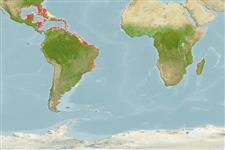Common names from other countries
Teleostei (teleosts) >
Eupercaria/misc (Various families in series Eupercaria) >
Haemulidae (Grunts) > Haemulinae
Etymology: Anisotremus: Greek, anisos = unequal + Greek, trema, -atos = hole (Ref. 45335).
More on author: Bloch.
Environment: milieu / climate zone / depth range / distribution range
Ecology
Marine; reef-associated; depth range 0 - 70 m (Ref. 9710), usually 0 - 15 m (Ref. 40849). Subtropical; 31°N - 35°S, 98°W - 28°W
Western Atlantic: Florida, USA and the Bahamas through the Gulf of Mexico and the Caribbean Sea to Brazil.
Size / Weight / Age
Maturity: Lm ? range ? - ? cm
Max length : 76.0 cm TL male/unsexed; (Ref. 40637); common length : 45.0 cm TL male/unsexed; (Ref. 3798); max. published weight: 5.8 kg (Ref. 40637)
Dorsal spines (total): 12; Dorsal soft rays (total): 18; Anal spines: 3; Anal soft rays: 9. Front half of body darker than rear. Soft dorsal and anal fins have dense scales on bases of interradial membranes (Ref. 26938). Fins dusky, anal and pelvic fins darkest; peritoneum not black; young with two black stripes and a black spot at base of caudal fin (Ref. 13442).
Maximum depth from Ref. 126840. Inhabits larger patch reefs and quickly sloping rocky bottoms. Often near the shelter of caves, ledges, or wrecks (Ref. 9710). Feeds at night on crustaceans, mollusks, smaller fish, and the long-spined urchin, Diadema. Marketed fresh.
Life cycle and mating behavior
Maturities | Reproduction | Spawnings | Egg(s) | Fecundities | Larvae
Distinct pairing during breeding (Ref. 205).
Robins, C.R. and G.C. Ray, 1986. A field guide to Atlantic coast fishes of North America. Houghton Mifflin Company, Boston, U.S.A. 354 p. (Ref. 7251)
IUCN Red List Status (Ref. 130435)
CITES (Ref. 128078)
Not Evaluated
Threat to humans
Reports of ciguatera poisoning (Ref. 30303)
Human uses
Fisheries: commercial; aquarium: public aquariums
Tools
Special reports
Download XML
Internet sources
Estimates based on models
Preferred temperature (Ref.
115969): 24.2 - 26.1, mean 25.5 (based on 19 cells).
Phylogenetic diversity index (Ref.
82804): PD
50 = 0.5039 [Uniqueness, from 0.5 = low to 2.0 = high].
Bayesian length-weight: a=0.02042 (0.01237 - 0.03369), b=3.01 (2.86 - 3.16), in cm Total Length, based on LWR estimates for this species & (Sub)family-body (Ref.
93245).
Trophic level (Ref.
69278): 3.6 ±0.2 se; based on diet studies.
Resilience (Ref.
120179): Low, minimum population doubling time 4.5 - 14 years (Preliminary K or Fecundity.).
Fishing Vulnerability (Ref.
59153): Moderate to high vulnerability (50 of 100).
